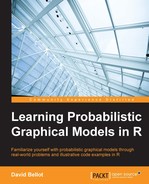In this last chapter, we saw more advanced probabilistic graphical models, whose solution is not easy to compute with standard tools such as the junction tree algorithm. This chapter set out to show that the graphical model framework can still be used even if one has to develop a special algorithm for each model. Indeed, in the LDA model, the solution to the variational problem appeared by looking at the graph of the original LDA and by transforming this graph, thus leading to a better approximation of the initial problem. So, even if the final algorithm does not use the graph directly like a junction tree algorithm would do, the solution came from the graph anyway.
This chapter proved how powerful probabilistic graphical models can be, and all the possibilities and new models that can be created from simpler models.
Indeed, each of these models can again be extended either by combining them—for example, in the mixture of experts model. In this model, each expert function could be replaced by another mixture of experts model, creating a hierarchical mixture of experts. This is a probabilistic version of the decision tree but with smooth transitions and an increased ability to deal with uncertainty.
We have finally reached the end of our journey into the world of probabilistic graphical models. But, as with all journeys, it is just a start and we encourage the reader to look for all the R packages dedicated to graphical models and to write his or her own algorithms. Following the graphs and the generic recipes found in this book, it is possible to go way beyond the standard models and solutions we presented here; the only limit is your imagination.
